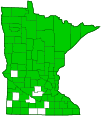Pennsylvania buttercup
(Ranunculus pensylvanicus)
Conservation • Wetland • Description • Habitat • Ecology • Use • Distribution • Taxonomy
Description |
||
Pennsylvania buttercup is a 8″ to 20″ tall, erect, annual or perennial forb. The roots are never tuberous. The stems are erect, branched or unbranched, and rough with firm, stiff hairs. The base is not bulbous. Basal leaves are broadly heart-shaped in outline, ⅝″ to 2¾″ long, and 1¼″ to 3½″ wide. They are on long leaf stalks that are covered with sharp, erect hairs. The leaves are divided into 3 leaflets. The terminal leaflet is on a distinct leaflet stalk. The lateral 2 leaflets may be stalked or unstalked. The leaflets are deeply divided into 3 lobes. The lobes are deeply toothed or have secondary lobes. The ultimate segments are narrowly elliptic, pointed, and have toothed margins. Basal leaves wither or dry early. Stem leaves are few and are all stalked. They are similar to basal leaves but smaller and on shorter leaf stalks. They get progressively smaller and shorter stalked as they ascend the stem. The inflorescence is a few solitary, short-stalked flowers at the end of the stem and branches. The flowers are ¼″ to ⅓″ wide. There are 5 sepals that bend downward, pointing to the ground, and 5 yellow, inversely egg-shaped, 1 ⁄16″ to ⅛″ long, 1 ⁄32″ to ⅛″ wide petals. The petals are shorter than the sepals. At the center of the flower there is a cluster of green carpels surrounded by a ring of stamens with yellow anthers. The fruit is an achene, borne in a 3 ⁄16″ to ¼″ wide, elongated, cylinder-shaped cluster. |
||
Height |
||
8″ to 20″ |
||
Flower Color |
||
Yellow |
||
Similar Species |
||
Kidney-leaved buttercup (Ranunculus abortivus) has mostly undivided, kidney-shaped basal leaves. |
||
Habitat |
||
Moist to wet. Stream banks, bogs, moist clearings, wet meadows. |
||
Ecology |
||
Flowering |
||
July to August |
||
Pests and Diseases |
||
|
||
Use |
||
|
||
Distribution |
||||
|
Sources Biodiversity occurrence data published by: Minnesota Biodiversity Atlas (accessed through the Minnesota Biodiversity Atlas Portal, bellatlas.umn.edu, 5/24/2023). |
|||
| 5/24/2023 | ||||
Nativity |
||||
Native |
||||
Occurrence |
||||
|
||||
Taxonomy |
|||
| Kingdom | Plantae (Plants) | ||
| Division | Tracheophyta (Vascular Plants) | ||
| Subdivision | Spermatophytina (Seed Plants) | ||
| Class | Magnoliopsida (Dicots) | ||
| Superorder | Ranunculanae | ||
Order |
Ranunculales (Buttercups, Poppies, and Allies) | ||
Family |
Ranunculaceae (Buttercup) | ||
| Subfamily | Ranunculoideae (Anemones, Buttercups, Larkspurs and Allies) | ||
| Tribe | Ranunculeae | ||
Genus |
Ranunculus (Buttercups) | ||
Subordinate Taxa |
|||
|
|||
Synonyms |
|||
|
|||
Common Names |
|||
bristly buttercup bristly crowfoot Pennsylvania buttercup |
|||
Glossary
Achene
A dry, one-chambered, single-seeded seed capsule, formed from a single carpel, with the seed attached to the membranous outer layer (wall) only by the seed stalk; the wall, formed entirely from the wall of the superior ovary, does not split open at maturity, but relies on decay or predation to release the contents.
Carpel
The female reproductive organ of a flower, consisting of an ovary, styles, and stigmas.
Sepal
An outer floral leaf, usually green but sometimes colored, at the base of a flower.
Visitor Photos |
|||||
Share your photo of this plant. |
|||||
| This button not working for you? Simply email us at info@MinnesotaSeasons.com. Attach one or more photos and, if you like, a caption. |
|||||
Luciearl |
|||||
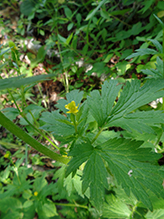 |
|||||
MinnesotaSeasons.com Photos |
|||||
Plant |
|||||
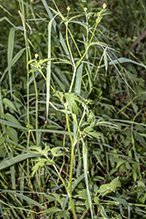 |
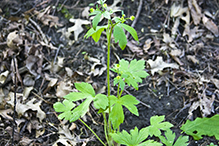 |
||||
Stem Leaf |
|||||
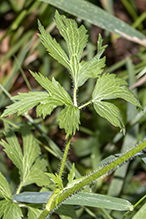 |
|||||

Slideshows |
||

Visitor Videos |
|||
Share your video of this plant. |
|||
| This button not working for you? Simply email us at info@MinnesotaSeasons.com. Attach a video, a YouTube link, or a cloud storage link. |
|||
Other Videos |
|||

Visitor Sightings |
|||||
Report a sighting of this plant. |
|||||
| This button not working for you? Simply email us at info@MinnesotaSeasons.com. Be sure to include a location. |
|||||
| Luciearl 7/9/2021 |
Location: Cass County Growing near the shoreline of Pine Song lake |
 |
|||
MinnesotaSeasons.com Sightings |
|||||

|
Created: Last Updated: © MinnesotaSeasons.com. All rights reserved. |
